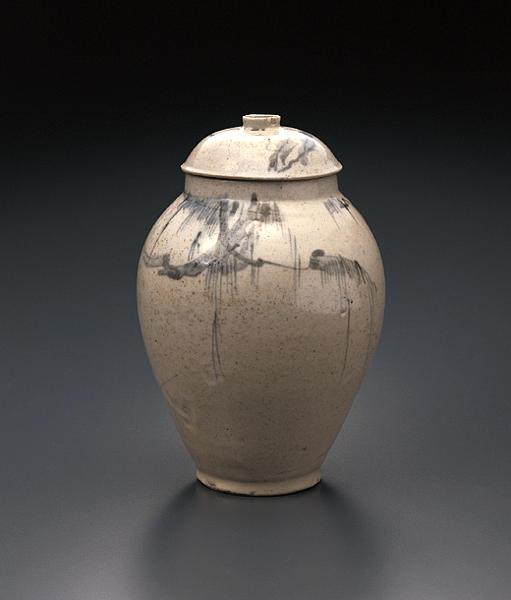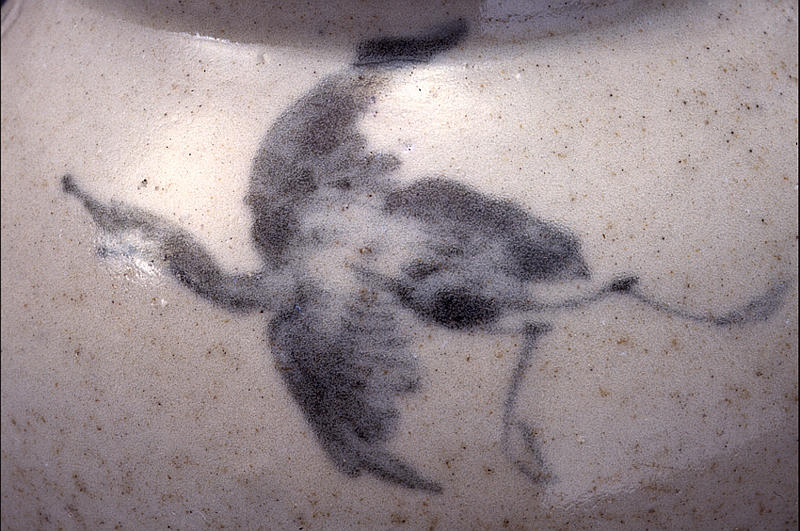伊万里染付鷺樹木文壺
- 佐賀県・有田窯
- 江戸時代
- 17c
- 呉須染付磁製
- H-22.8 D-16
江戸時代 17世紀
高:22.8cm 口径:9.2cm 胴径:15.5cm 底径:7.8cm
染付で,壷の肩に飛ぶ鷺を一羽描いただけのシンプルなデザインは,一見,李朝染付を思わせないでもない。しかし,肩部が強く張り,胴部下半が締まる形状のものが多い李朝染付の壷のなかに,本例のような倒卵形の肩の張りの弱いプロポーションの類例はほとんど見うけられない。胎土や釉調も考慮に入れれば,伊万里とみなしておいた方が妥当であろうか。
鷺文の裏面に描かれた樹木文は,枝垂柳のような葉を茂らせているが,枝振りから見て柳とは思われず,樹種を特定することは難しい。ピンホールが多く,わずかに青味をおびた白磁釉が,蓋・身とも外面のほぼ全面に施されており,染付の呉須の発色はやや黒ずんだ青である。伊万里であれば,呉須の発色の色合いから考えて,比較的初期のものと思われるが,描かれている鷺文は初期伊万里でしばしば見うけられるものとはいささか趣を異にしている。 (尾野)
伊万里焼(いまり)
佐賀県有田町で焼かれた磁器。隣接する伊万里港から製品のほとんどが出荷されたため当初からこう呼ばれました。唐津同様、豊臣秀吉による文禄・慶長の役(丁酉倭乱)で日本に連れてこられた朝鮮の陶工・李参平(りさんぺい)が有田町泉山(いずみやま)に白磁鉱脈を発見し、元和二年(1616)に白磁の焼成に成功したといわれています。中国古染付の影響を受けた初期の作品は特に初期伊万里(古伊万里)と呼ばれます。
伊万里染付四君子文徳利
伊万里染付草花文大皿
Catalogue Entry
Edo period, 17th century
Imari ware, underglaze blue
Height, 22.8cm; mouth diameter, 9.2cm;
torso diameter, 15.5cm; base diameter, 7.8cm
A flying egret has been depicted in underglaze blue on the shoulder of this jar, and this simple design might, at first glance, conjure an image of Korean Yi dynasty blue-and-white wares; however, there are almost no examples of Yi dynasty blue-and-white jars with proportions similar to those of this jar which is characterized by an egg shape with little shoulder swell. Generally, Yi dynasty jars are wide-shouldered and narrow-hipped. The body clay and the glazing seem to indicate that this is an example of Imari ware.
The tree motif painted directly opposite the egret motif has a luxuriant growth of leaves that looks like those of a weeping willow tree, but the branch style does not appear to be willow, and thus it is hard to determine the type of tree depicted. There are many pinholes, and a white porcelaneous glaze with a slight bluish tinge covers almost the entire exterior of body and lid. The underglaze cobalt-blue pigment has been fired to a slightly blackened blue appearance. If this is an Imari ware piece, the manner in which the underglaze cobalt was fired would indicate a relatively early date for this work; and yet, while the egret pattern appears occasionally in early Imari wares, the expression of the motif differs slightly from that seen here. YO


